
John Houseman
1881 - 1916
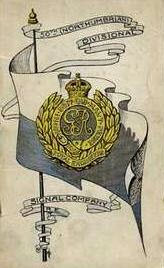
We have no Service Record for John Houseman but we know from his
Medal Card that he was in the Northumberland Fusiliers, his numbers
being 414098 & 201369.
Medal Card that he was in the Northumberland Fusiliers, his numbers
being 414098 & 201369.
We know from the Commonwealth Graves Commission that he was a
Private, his battalion (1/4th Bn Northumberland Fusiliers), the date he died
& where his memorial is.
Private, his battalion (1/4th Bn Northumberland Fusiliers), the date he died
& where his memorial is.
In France
The 1/4th bn Northumberland Fusiliers were part of the 149th (Northumberland) Brigade of the 50th
(Northumbrian) Division. The Northumbrian Division was a Territorial Force Division already in existence
at the outbreak of the war. The Division and Brigades were not numbered until April 1915 previously just
named. Arrived in France in April 1915. In June 1918 the Division was so under manned that the Brigades
were reformed into Battalions and designated 149th , 150th and 151st Brigade Battalions. These
Battalions formed the 50th Division Composite Brigade.
The Division was reduced to Cadre in June 1918 and reconstituted in July 1918. Served in France and
Flanders until the Armistice.
John served in France and Flanders, with the 50th Division, most probably taking part in:
1916
The Battle of the Somme (Battle of Flers Courcellete (15-
A subsidiary attack of the Somme Offensive, the Battle of Flers-
September. Twelve Divisions were employed, along with all the tanks that the British Army possessed, 49.
John Houseman was killed on the 15th of September 1916 so it would seem likely that this was
on the first day of fighting at the battle of Flers Courcelette during the Battle of the Somme.
Because of his overseas service in a theatre of war he was qualified to wear the British War Medal and
Victory Medal. As he did not qualify for the 1914-
Private - service number 201369
1/4th Northumberland Fusiliers

Often known as the "Fighting Fifth" as the regiment was until 1881 the Fifth Foot, the Northumberland Fusiliers raised
no fewer than 51 battalions for service in the Great War. This makes it the second largest after the London Regiment.
no fewer than 51 battalions for service in the Great War. This makes it the second largest after the London Regiment.
Battalions of the Regular Army
1st Battalion
August 1914 : in Portsmouth. Part of 9th Brigade, 3rd Division.
Landed at Le Havre 14 August 1914.
2nd Battalion
August 1914 : in Sabathu in India. Returned to England 22 December 1914. Joined 84th Brigade, 28th Division.
Landed at Le Havre 18 January 1915. Moved to Egypt October 1915 and thence to Salonika.
June 1918 : left Brigade and moved to France. Joined 150th Brigade, 50th (Northumbrian) Division.
3rd (Reserve) Battalion
August 1914 : in Newcastle on Tyne. A training unit, it remained in UK throughout the war.
Moved to East Boldon in August 1914, then to Sunderland.
Battalions of the Territorial Force
1/4th Battalion
August 1914 : in Hexham. Part of Northumberland Brigade, Northumbrian Division.
April 1915 : landed in France.
May 1915 : became 149th Brigade, 50th (Northumbrian) Division, in France.
15 July 1918 : reduced to cadre strength and transferred to Lines of Communication.
16 August 1918 : transferred to 118th Brigade, 39th Division.
10 November 1918 : disbanded in France.
1/5th Battalion
August 1914 : in Walker. Part of Northumberland Brigade, Northumbrian Division.
Record same as 1/4th Battalion.
1/6th Battalion
August 1914 : in St George's Drill Hall, Newcastle. Part of Northumberland Brigade, Northumbrian Division.
Record same as 1/4th Battalion.
1/7th Battalion
August 1914 : in Alnwick. Part of Northumberland Brigade, Northumbrian Division.
Record same as 1/4th Battalion up to February 1918.
12 February 1918 : transferred to 42nd (East Lancashire) Division and converted to Pioneer Battalion.
2/4th, 2/5th and 2/6th Battalions
2/4th and 2/5th formed at Blyth, 23 and 22 November 1914, and 2/6th at Newcastle, 28 December 1914.
January 1915 : placed under orders of 188th Brigade, 63rd (2nd Northumbrian) Division.
July 1916, Division broken up.
November 1916 : transferred to 217th Brigade, 72nd Division.
December 1917, 2/6th and 2/5th disbanded in England, 24 May 1918 2/4th same.
2/7th Battalion
Formed at Alnwick, 26 September 1914.
January 1915 :attached to 188th Brigade, 63rd (2nd Northumbrian) Division.
July 1916, Division broken up.
20 January 1917: sailed for Egypt for duty as a Garrison Battalion.
3/4th, 3/5th, 3/6th and 3/7th Battalions
Formed at home bases in June 1915, respectively.
8 April 1916 : all became Reserve Battalions
All others absorbed into 4th (Reserve) Battalion.
35th Battalion
1 January 1917, the 21st Provisional Bn became 35th Bn TF. The 41st had been formed in 1915 from Home Service
personnel from the TF Bns of the regiment.
36th Battalion
1 January 1917, the 22nd Provisional Bn became 36th Bn TF. The 36th had been formed in 1915 from Home Service
personnel from the TF Bns of the regiment.
Went to France in May, 1918 as a Garrison Guard Battalion : then attached to 178th Brigade, 59th (2nd North Midland)
Division
Battalions of the New Armies
8th (Service) Battalion
Formed at Newcastle in August 1914 as part of K1 and attached to 34th Brigade, 11th (Northern) Division.
Moved to Gallipoli in July 1915. Went to Egypt in January 1916 and thence to France in July 1916.
9th (Service) Battalion
Formed at Newcastle in September 1914 as part of K2 and attached to 52nd Brigade, 17th (Northern) Division.
Landed in France in July 1915.
August 1917 : transferred to 103rd Brigade, 34th Division.
25 September 1917 : absorbed the 2/1st Northumberland Yeomanry and became the 9th (Northumberland Hussars
Yeomanry) Bn.
26 May 1918 : transferred to 183rd Brigade, 61st (2nd South Midland) Division.
10th (Service) Battalion
Formed at Newcastle in September 1914 as part of K3 and attached to 68th Brigade, 23rd Division.
Landed in France August 1915.
Moved to Italy with the Division in November 1917.
11th (Service) Battalion
Record same as 10th (Service) Battalion.
12th (Service) Battalion
Formed at Newcastle in September 1914 as part of K3 and attached to 62nd Brigade, 21st Division.
Landed in France September 1915.
10 August 1917: amalgamated with 13th Bn, becoming 12/13th Battalion.
13th (Service) Battalion
Record same as 12th Battalion.
14th (Service) Battalion (Pioneers)
Formed at Newcastle in September 1914 as part of K3 and attached as Army Troops to 21st Division.
January 1915 : converted into Pioneer Battalion.
Landed in France September 1915.
15th (Reserve) Battalion
Formed in Darlington in October 1914 as a Service battalion, part of K4.
November 1914 : attached to 89th Brigade, original 30th Division.
10 April 1915 : became a Reserve battalion.
September 1916 : absorbed into Training Reserve Battalions in 1st Reserve Brigade.
16th (Service) Battalion (Newcastle)
Formed at Newcastle in September 1914 by the Newcastle & Gateshead Chamber of Commerce.
June 1915 : attached to 96th Brigade, 32nd Division.
Landed at Boulogne 22 November 1915.
February 1918 : disbanded in Belgium.
17th (Service) Battalion (North Eastern Railway Pioneers)
Formed at Hull in September 1914 by the North Eastern Railway Company.
January 1915 : became a Pioneer Bn.
June 1915 : attached as Divisional Troops to 32nd Division.
Landed at La Havre 21 November 1915.
19 October 1916 : transferred to GHQ as Railway Construction Troops.
2 September 1917 : rejoined 32nd Division, leaving on 15 November 1917, again to GHQ as Railway Construction
Troops.
31 May 1918 : transferred as Divisional Troops to 52nd (Lowland) Division.
18th (Service) Battalion (1st Tyneside Pioneers)
Formed at Newcastle, 14 October 1914, by the Lord Mayor and City.
8 February 1915 : became a Pioneer Bn.
16 June 1915 : attached as Divisional Troops to 34th Division.
Landed at Le Havre 8 January 1916.
8 May 1918 : reduced to cadre strength.
17 June 1918 : transferred as infantry to 116th Brigade, 39th Division.
29 July 1918 : transferred to 118th Brigade in same Division.
29 July 1918 : transferred as Divisional Troops to 66th (2nd East Lancashire) Division.
20 September 1918 : transferred with 197th Brigade to Lines of Communication.
19th (Service) Battalion (2nd Tyneside Pioneers)
Formed at Newcastle, 16 November 1914, by the Lord Mayor and City.
8 February 1915 : became a Pioneer Bn.
July 1915 : attached as Divisional Troops to 35th Division.
Landed at Le Havre 29 January 1916.
20th (Service) Battalion (1st Tyneside Scottish)
Formed at Newcastle, 14 October 1914, by the Lord Mayor and City.
June 1915 : attached to 102nd Brigade, 34th Division.
Landed in France in January 1916.
3 February 1918 : disbanded in France.
21st (Service) Battalion (2nd Tyneside Scottish)
Formed at Newcastle, 26 October 1914, by the Lord Mayor and City.
Record same as 1st Tyneside Scottish.
22nd (Service) Battalion (3rd Tyneside Scottish)
Formed at Newcastle, 5 November 1914, by the Lord Mayor and City..
June 1915 : attached to 102nd Brigade, 34th Division.
Landed in France in January 1916.
Landed in France in January 1916.
17 May 1918 : reduced to cadre strength; returned to England 18 June 1918 with the 16th (Irish)Division.
18 June 1918 : absorbed new 38th Bn, and then attached to 48th Brigade, 16th Division.
Landed in France in July 1918.
23rd (Service) Battalion (4th Tyneside Scottish)
Formed at Newcastle, 16 November 1914, by the Lord Mayor and City..
June 1915 : attached to 102nd Brigade, 34th Division.
Landed in France in January 1916.
Landed in France in January 1916.
17 May 1918 : reduced to cadre strength.
17 June 1918 : transferred to 116th Brigade, 39th Division.
29 July 1918 : transferred to 197th Brigade, 66th (2nd East Lancashire) Division.
20 September 1918 : transferred with 197th Brigade to Lines of Communication.
24th (Service) Battalion (1st Tyneside Irish)
Formed at Newcastle, 14 November 1914, by the Lord Mayor and City.
June 1915 : attached to 103rd Brigade, 34th Division.
Landed in France in January 1916.
10 August 1917 : amalgamated with 27th Bn to form 24/27th Battalion.
26 February 1918 : disbanded in France.
25th (Service) Battalion (2nd Tyneside Irish)
Formed at Newcastle, 9 November 1914, by the Lord Mayor and City..
June 1915 : attached to 103rd Brigade, 34th Division.
Landed in France in January 1916.
Landed in France in January 1916.
3 february 1918 : transferred to 102nd Brigade in same Division.
16 May 1918 : reduced to cadre strength.
17 June 1918 : transferred to 116th Brigade, 39th Division.
29 July 1918 : transferred to 197th Brigade, 66th (2nd East Lancashire) Division.
20 September 1918 : transferred with 197th Brigade to Lines of Communication.
26th (Service) Battalion (3rd Tyneside Irish)
Formed at Newcastle, November 1914, by the Lord Mayor and City.
June 1915 : attached to 103rd Brigade, 34th Division.
Landed in France in January 1916.
3 February 1918 : disbanded in France.
27th (Service) Battalion (4th Tyneside Irish)
Formed at Newcastle, January 1915, by the Lord Mayor and City.
June 1915 : attached to 103rd Brigade, 34th Division.
Landed in France in January 1916.
10 August 1917 : amalgamated with 27th Bn to form 24/27th Battalion.
26 February 1918 : disbanded in France.
28th (Reserve) Battalion
Formed in Cramlington in July 1915 as a Reserve battalion, from depot companies of 18th and 19th Bns.
1 September 1916 : absorbed into Training Reserve Battalions in 19th Reserve Brigade.
29th (Reserve) Battalion
Formed in Alnwick in July 1915 as a Reserve battalion, from depot companies of Tyneside Scottish Bns.
1 September 1916 : converted into 84th Training Reserve Battalion in 20th Reserve Brigade.
30th (Reserve) Battalion
Formed in Woolsington in July 1915 as a Reserve battalion, from depot companies of Tyneside Irish Bns.
1 September 1916 : converted into 85th Training Reserve Battalion in 20th Reserve Brigade.
31st (Reserve) Battalion
Formed in Catterick in July 1915 as a Reserve battalion, from depot company of 16th Bn.
1 September 1916 : converted into 86th Training Reserve Battalion in 20th Reserve Brigade.
32nd (Reserve) Battalion
Formed in Ripon in July 1915 as a Reserve battalion, from depot company of 17th Bn.
1 September 1916 : converted into 80th Training Reserve Battalion in 19th Reserve Brigade.
33rd (Reserve) Battalion
Formed in Hornsea in June 1916 from 29th (Reserve) Battalion.
1 September 1916 : converted into 80th Training Reserve Battalion in 19th Reserve Brigade.
34th (Reserve) Battalion
Formed in Hornsea in June 1916 from 30th (Reserve) Battalion.
1 September 1916 : absorbed into Training Reserve Battalions in 19th Reserve Brigade.
Other Battalions
37th (Home Service) Battalion
Formed in Margate on 27 April 1918.
38th (Home Service) Battalion
Formed in Margate on 1 June 1918 but absorbed into 22nd Bn on 18 June.
1st Garrison Battalion
Formed in August 1915 and went to Malta.
2nd Garrison Battalion
Formed in Newcastle in October 1915 and went to India.
3rd (Home Service) Garrison Battalion
Formed in Sunderland in March 1916 and went to Ireland.
The Northumberland Fusiliers
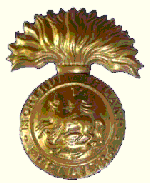

Private John Houseman
died on the 15 September 1916, Aged 35
whilst serving with the
1/4th Bn Northumberland Fusliers.
He has no known grave but is remembered at the
Thiepval Memorial Cemetery in France
(Location Pier and Face 10 B 11 B and 12 B.)
died on the 15 September 1916, Aged 35
whilst serving with the
1/4th Bn Northumberland Fusliers.
He has no known grave but is remembered at the
Thiepval Memorial Cemetery in France
(Location Pier and Face 10 B 11 B and 12 B.)


On 1 July 1916, supported by a French attack to the south, thirteen divisions of Commonwealth
forces launched an offensive on a line from north of Gommecourt to Maricourt. Despite a
preliminary bombardment lasting seven days, the German defences were barely touched and the
attack met unexpectedly fierce resistance. Losses were catastrophic and with only minimal
advances on the southern flank, the initial attack was a failure.
In the following weeks, huge resources of manpower and equipment were deployed in an attempt to
exploit the modest successes of the first day. However, the German Army resisted tenaciously and
repeated attacks and counter attacks meant a major battle for every village, copse and farmhouse
gained. At the end of September, Thiepval was finally captured. The village had been an original
objective of 1 July. Attacks north and east continued throughout October and into November in
increasingly difficult weather conditions. The Battle of the Somme finally ended on 18 November
with the onset of winter.
In the spring of 1917, the German forces fell back to their newly prepared defences, the Hindenburg
Line, and there were no further significant engagements in the Somme sector until the Germans
mounted their major offensive in March 1918. The Thiepval Memorial, the Memorial to the Missing
of the Somme, bears the names of more than 72,000 officers and men of the United Kingdom and
South African forces who died in the Somme sector before 20 March 1918 and have
no known grave.
Over 90% of those commemorated died between July and November 1916. The memorial also
serves as an Anglo-French Battle Memorial in recognition of the joint nature of the 1916 offensive
and a small cemetery containing equal numbers of Commonwealth and French graves lies at the
foot of the memorial. The memorial, designed by Sir Edwin Lutyens, was built between 1928 and
1932 and unveiled by the Prince of Wales, in the presence of the President of France, on 1 August
1932 (originally it had been scheduled for 16 May, but due to the sudden death of French President
Doumer, as a mark of respect, the ceremony was postponed until August).
The dead of other Commonwealth countries, who died on the Somme and have no known graves,
are commemorated on national memorials elsewhere.
forces launched an offensive on a line from north of Gommecourt to Maricourt. Despite a
preliminary bombardment lasting seven days, the German defences were barely touched and the
attack met unexpectedly fierce resistance. Losses were catastrophic and with only minimal
advances on the southern flank, the initial attack was a failure.
In the following weeks, huge resources of manpower and equipment were deployed in an attempt to
exploit the modest successes of the first day. However, the German Army resisted tenaciously and
repeated attacks and counter attacks meant a major battle for every village, copse and farmhouse
gained. At the end of September, Thiepval was finally captured. The village had been an original
objective of 1 July. Attacks north and east continued throughout October and into November in
increasingly difficult weather conditions. The Battle of the Somme finally ended on 18 November
with the onset of winter.
In the spring of 1917, the German forces fell back to their newly prepared defences, the Hindenburg
Line, and there were no further significant engagements in the Somme sector until the Germans
mounted their major offensive in March 1918. The Thiepval Memorial, the Memorial to the Missing
of the Somme, bears the names of more than 72,000 officers and men of the United Kingdom and
South African forces who died in the Somme sector before 20 March 1918 and have
no known grave.
Over 90% of those commemorated died between July and November 1916. The memorial also
serves as an Anglo-
foot of the memorial. The memorial, designed by Sir Edwin Lutyens, was built between 1928 and
1932 and unveiled by the Prince of Wales, in the presence of the President of France, on 1 August
1932 (originally it had been scheduled for 16 May, but due to the sudden death of French President
Doumer, as a mark of respect, the ceremony was postponed until August).
The dead of other Commonwealth countries, who died on the Somme and have no known graves,
are commemorated on national memorials elsewhere.
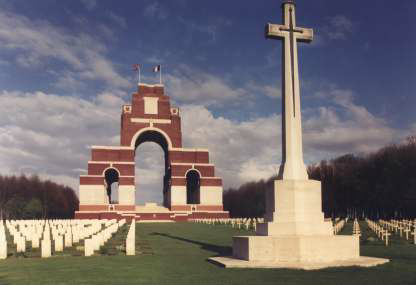
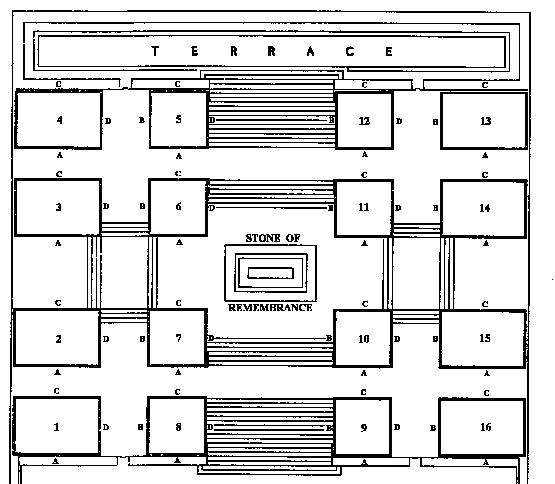
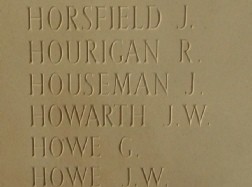
Thiepval Memorial
The Courcellete British Cemetery, near Thiepval, contains 1967 burials of which 1177 are
unidentified. As it is probable that John died whilst fighting at the Battle of Flers-Courcellete,
he could well be buried here, without recognition
unidentified. As it is probable that John died whilst fighting at the Battle of Flers-
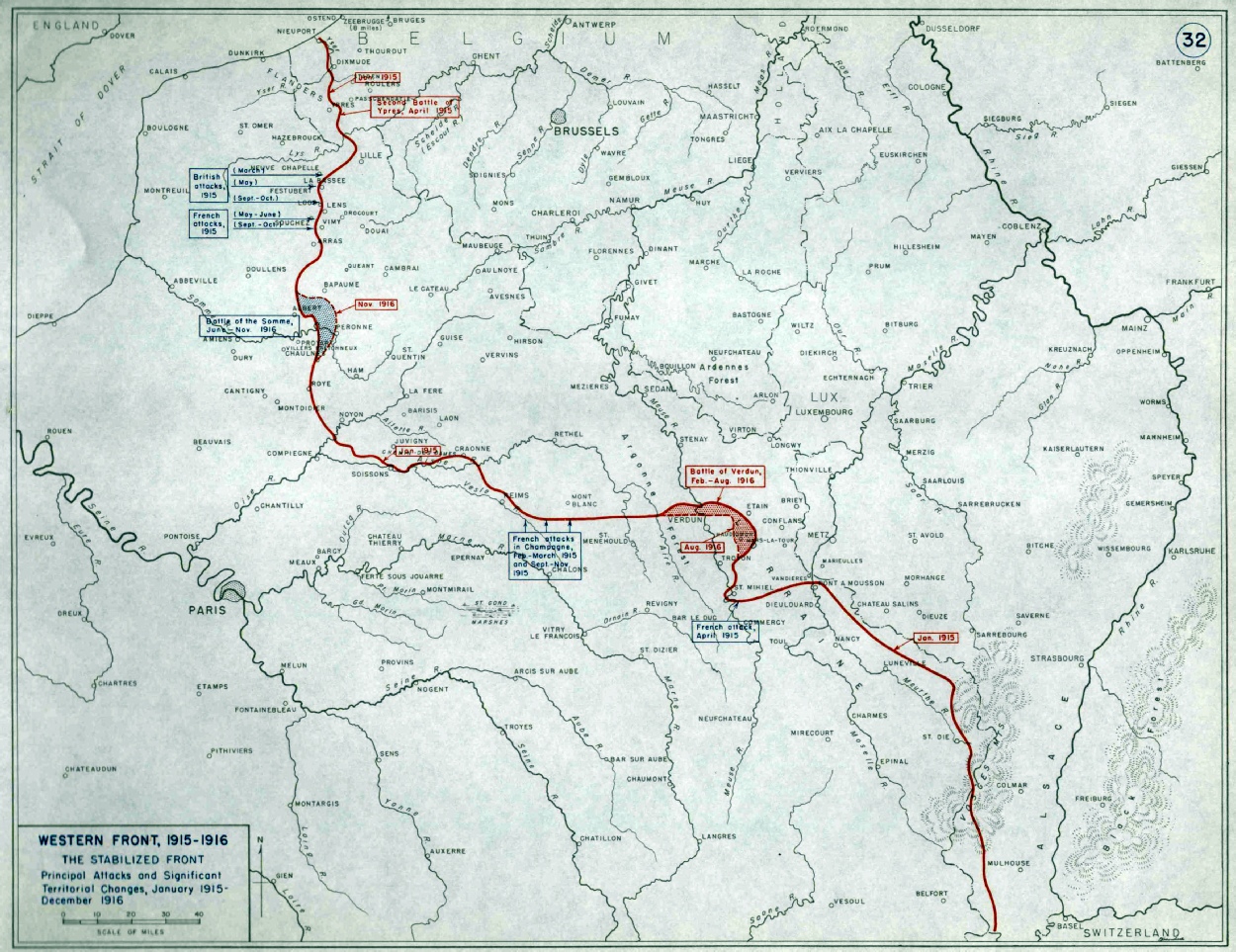

= The Battle of the Somme
Hover your mouse over a circle
for more information
for more information
1916
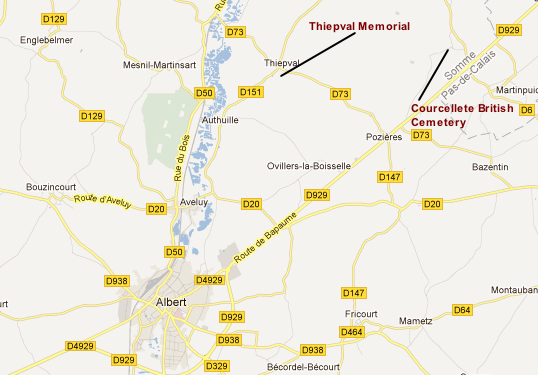
= Thiepval Memorial
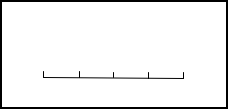
SCALE IN MILES
0
10
20
30
Western Front 1914 -1918